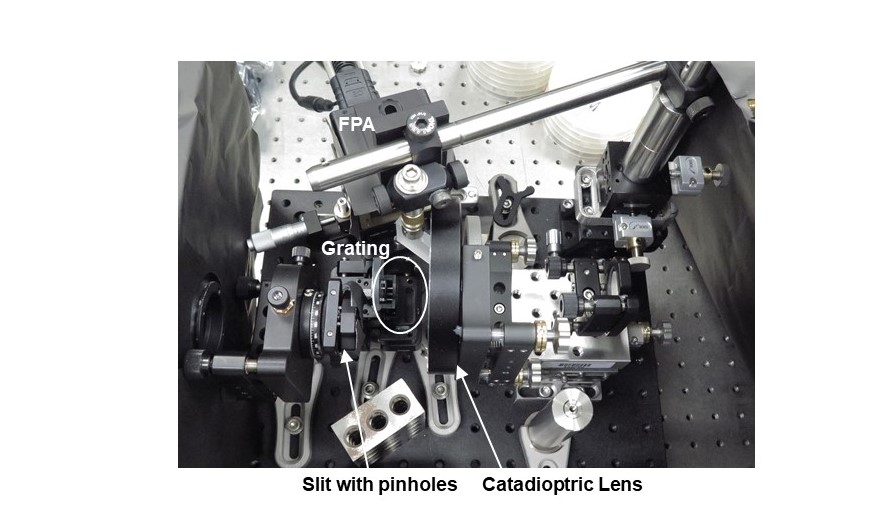About
05 November 2020
Researchers Shrink Imaging Spectrometer without Compromising Performance
Compact instrument paves the way to advanced spectral analysis from drones and satellites
WASHINGTON — Researchers have developed a new imaging spectrometer that is much lighter and smaller than state-of-the-art instruments while maintaining the same high level of performance. Because of its small size and modular design, the new instrument is poised to bring this advanced analytical technique to airborne vehicles and even planetary exploration missions.
Imaging spectrometers record a series of monochromatic images that are used for both spatial and spectral analysis of an area. This analytical approach is widely applied in fields such as atmospheric science, ecology, geology, agriculture and forestry. However, the large size of the instruments has prevented it from being used in some applications.

Caption: Researchers developed a compact imaging spectrometer by using a catadioptric lens that combines reflective and refractive elements into one component. They also used a special flat immersion reflection grating that takes up less space than a traditional grating while maintaining the same resolution.
Credit: Ronald B. Lockwood, MIT Lincoln Laboratory
In the Optical Society (OSA) journal Applied Optics, researchers led by Ronald B. Lockwood from MIT Lincoln Laboratory describe their new Chrisp compact VNIR/SWIR imaging spectrometer (CCVIS). It has a volume about 10 or more times smaller than most of today’s devices. One version of the CCVIS is 8.3 cm in diameter and 7 cm long, about the size of a soda can.
The spectrometer is designed to record spectral images over wavelengths spanning 400 to 2500 nm. This includes the visible and near infrared (VNIR) as well as shortwave near infrared (SWIR) portions of the spectrum.
“Our compact instrument facilitates the application of imaging spectroscopy for a variety of scientific and commercial problems, such as deployment on small satellites for planetary exploration or using unmanned aerial systems for agricultural purposes,” said Lockwood. “We believe that our new spectrometer could also be used to study climate change, one of the most exciting applications of an imaging spectrometer.”
Making a smaller spectrometer
Most of today’s imaging spectrometers use an Offner-Chrisp optical configuration because it offers excellent control of optical errors called aberrations. However, this design requires a relatively large optical setup. The new CCVIS developed by the researchers performs much like the Offner-Chrisp configuration but with new optical components that create a more compact design.
To make the new CCVIS, the researchers used a catadioptric lens that combines reflective and refractive elements into one component. This created a more compact instrument while still controlling optical aberrations. The researchers also used a special flat reflection grating that is immersed in a refractive medium rather than in air. This grating takes up less space than a traditional grating while maintaining the same resolution.
Easy manufacturing
“The CCVIS uses a flat grating rather than a concave or convex grating that requires manufacturing with complex electron-beam lithography or diamond machining techniques,” said Lockwood. “We developed a grayscale photolithographic microfabrication approach that uses a one-time exposure to make the grating and doesn’t require labor intensive electron-beam processing.”
To test their new design, the researchers demonstrated the spectrometer using a laboratory setup. Their experiments verified that the CCVIS had the expected performance over the full field of view.
“The CCVIS’s compact size means that it can be made into modules that could be stacked to increase the field of view,” said Lockwood. “It also makes it relatively easy to keep stable with no temperature changes so that optical alignment, and thus spectral performance, remains unchanged.”
As a step toward the ultimate goal of a space-based demonstration, the researchers are seeking funding to develop a full prototype that could be thoroughly tested from an airborne vehicle.
Paper: M. P. Chrisp, R. B. Lockwood, M. A. Smith, G. Balonek, C. Holtsberg, K. J. Thome, K. E. Murray, P. Ghuman, “Development of a Compact Imaging Spectrometer Form for the Solar Reflective Spectral Region,” Applied Optics, 59, 32, 10007-10017 (2020).
DOI: https://doi.org/10.1364/AO.405303
About The Optical Society
The Optical Society (OSA) is dedicated to promoting the generation, application, archiving, and dissemination of knowledge in optics and photonics worldwide. Founded in 1916, it is the leading organization for scientists, engineers, business professionals, students, and others interested in the science of light. OSA’s renowned publications, meetings, online resources, and in-person activities fuel discoveries, shape real-life applications and accelerate scientific, technical, and educational achievement.
About Optical Materials Express
Optical Materials Express is an open-access journal focusing on the synthesis, processing and characterization of materials for applications in optics and photonics. It is published by Optica Publishing Group and emphasizes advances in novel optical materials, their properties, modeling, synthesis and fabrication techniques; how such materials contribute to novel optical behavior; and how they enable new or improved optical devices. The Editor-in-Chief is Andrea Alù from City University of New York, USA. For more information, visit Optical Materials Express.
Media Contact
